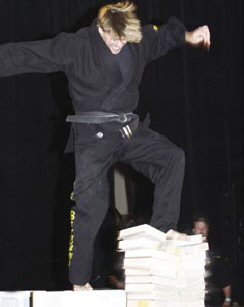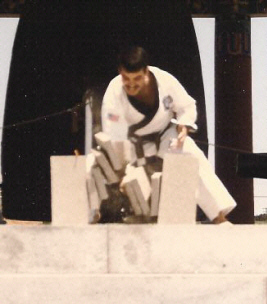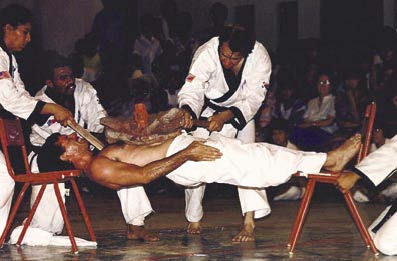Reprinted with permission
Tae Kwon Do Times - September 2007
About The Author
Kwan Jang Nim John St.
James is a 8th degree black belt and the owner/chief
instructor of
Karate World
in Suwanee, Georgia. He is also the founder and president of the
Atlantic-Pacific Tang Soo Do Federation
and has trained many
world-class martial artists including Master Leif Becker, a current
world record holder in breaking.
Breaking Through Your Limitations
A break is a break is a break...or is it?
Students practice breaking to demonstrate
power, speed, focus and proper understanding of technique. This practice
is done in preparation to testing to the next level. Although this can
be a good thing, it often results in frustration, embarrassment, and
feeling of failure when things don't go right. The reasons for this are
many and yet the main reason is often a lack of understanding and
proper preparation. Breaking is all about empowering ourselves to step
out of our comfort zone and face the two primary fears that hold people
back from realizing their true potential. Those two primary fears are
the fear of failure and the fear of rejection or embarrassment. When
breaking is used as a motivational tool, it can become not only a
wonderful way to empower a martial arts student but also a great way to
show students how to live their lives at a higher level outside the
studio. In this article, I will cover some of the ways that world-class
breakers go about breaking. To gain further insight, I interviewed
Master Leif Becker of Southbury Academy of Karate in Southbury,
Connecticut. Master Becker currently holds the world record for breaking
the most boards (487) in one minute.
When studying the art of breaking it is
important to split the curriculum (both mental and physical) into two
basic components: The right physical strategy and the right mental
strategy or psychology. The overall right strategy is taking the proper
steps that have to be in place in order to get a consistently successful
result. For example, the right psychology is using your mind to see
things in a way that will bring you closer to your goal(s). It requires
the student to know and use the proper mindset (thinking patterns) that
leads to a reliably triumphant outcome. In this way, the student of the
art of breaking learns how to use their mind and their body in synergy
to actualize their true potential.
The Right Physical Strategy
Safety First
Instructors must first decide which techniques are best for
their students. Factors would include both age and ability. Stay away
from joints and focus on other areas of the body without injuring
developing bones. An example of this could include using a palm strike
or elbow strike instead of a closed hand punch. An instructor then
begins to discuss mechanics as a student's abilities increase. Proper
body alignment and development of power while striking leads to
successful execution. Most injuries occur due to a lack of understanding
of proper body mechanics and delivery. To be successful, one must
constantly work on the proper mechanics of each technique. For example,
Master Becker practiced the proper body mechanics every other day for
three months before his world record attempt. Look at the best breakers,
forms competitors and weapons specialists in the world and you will no
doubt find that they continue to practice the fundamental basics every
day.
Physical Conditioning
Conditioning is another key to successful
breaking. You need to strengthen your body and understand that
conditioning is about more than just developing strength. It includes
developing both strength and stamina. Listed below are some specific
areas martial artists must develop to become successful at breaking.
These drills are used to develop strength and stamina.
●
Endurance Training -
Breaking is more than power alone. Individuals must be balanced within
as well. Endurance ensures
that an individual will stay focused and continue to deliver power over
an extended period of time.
This important factor dramatically lessens the possibility of an injury
when attempting multiple
breaks. Endurance training should include both longer sessions,
approximately 30 minutes, as well
as short explosive endurance drills such as sprinting or hill climbs.
●
Strength Training -
Breaking does require power, therefore martial artists need to ensure
they are working with weights if
they choose to compete at breaking at a high level. This is a very
effective drill taken right out of
Master Becker's training regimen. In this specific drill, you take a
technique or type of lift (if weight
training) and perform it continuously for one minute. This exercise is
extremely important to begin
developing the mindset needed for longer breaking performances. For
example, Master Becker used
this drill to develop the strength, stamina and mental preparation for a
full minute of intense breaking
which led to his world record.
●
Body Conditioning - This
should include training on a makiwara board (a striking board of
Okinawan origin) or something
similar to condition your hand or foot. Conditioning should happen on a
regular basis. This important
technique conditions the body as well as the mind.
The Right Mental Strategy
|
 |
|
|
Master Leif Becker |
|
Possibility Thinking
What type of break do you
want to attempt? You need to consider your current level of expertise
and the type of technique that is best suited for your body type. I
recommend that you start by asking your instructor what technique he or
she would like you to practice. Next, you should consider your current
level of conditioning as discussed above and start from there. Set up
short-term, small goals and take action. The Law of Incremental Change
states that "it is hard by the yard but a cinch by the inch."
Decide in Advance
After you have chosen your
specific goal, you must decide in advance how much time it will take to
reach your goal. Proper preparation is critical. Set a training schedule
in the dojang and at home that will allow for enough time to properly
prepare. The amount of time needed will be in direct proportion to the
degree of difficulty of the break and your current level of mental and
physical conditioning. Here again, I suggest you discuss this with your
instructor for more guidance as it relates to establishing time frames
that make sense.
Reverse Engineering
Create the action steps that
will take you from where you are to where you want to be. My
recommendation is to use a planner and decide specific times and days
you will condition yourself both mentally and physically. For example,
you might train in the dojang on Tuesdays and Thursdays and hit the gym
on Wednesdays and Fridays. You could schedule 30 minutes of bag work
and/or target training per day at home to review your specific breaking
technique. The key is to be consistent in your training and map your
progress. Make your action steps SMART (Specific, Measurable,
Attainable, Realistic/Relevant, and Time bound).
| |
 |
| |
Kwan Jang
Nim John St. James |
|
|
Start Small and Work
Your Way Up
The key to reaching any
large goal, including breaking, is to start small and work your way up.
Once you have perfected proper body mechanics, it is time to work on
focus and conditioning. Start with smaller/thinner boards before moving
up to an advanced level. If your goal is to break three boards with a
stepping side kick, you might start with one motivational board or
something similar and then progress to a regular board that is eight to
ten inches. After several successful attempts, you can then progress to
either a twelve-inch board or two eight-inch boards. From there, you
move steadily towards your goal of breaking three eight, ten and/or
twelve-inch boards.
See It To Believe It
We all have the ability to
visualize success before it ever occurs. To do this, simply imagine what
it will look like, feel like, and how it will sound when you
successfully complete your break. See yourself as the lead actor in a
a movie featuring world-class breakers. The goal is to run the movie
over and over again in your mind. Make it vivid and sharp. Put it in
high definition and try zooming in on the target before you start the
break. Play with this until you become good at it. The effort will be
well worth it in the end.
 |
|
|
Kwan Jang
Nim John St. James |
|
|
|
Other Considerations
As you think and plan your
next break, consider whether you will use a single breaking station or
multiple stations. You will also need to consider whether to execute a
stationary break and/or attempt a supported or unsupported speed break.
Your decision should be based upon your confidence level, conditioning
and overall competency. You also want to consider how many holders you
will need and, if possible, gain commitments well in advance from them.
Your instructor will be glad to help you with this. The fact is that
even though breaking is an individual pursuit, it takes a great team
(including competent holders) to get the job done. The more your team is
together and working in the same direction, the better the chance to
achieve your goal.
Other considerations include
the type of material used for the break (wood, brick, cinder block) and
whether or not spacers are used for stationary breaks. Also consider
what type of spacer will compliment your goal. For example, the type of
spacer used in competition may be completely different from the type of
spacer used for a performance.
Don't Forget
Creativity
Finally, many breakers use their creativity to produce an overall
effect depending on the audience and circumstances. For example,
Master Becker and his world-class breaking team combine different
breaking materials, music, choreography, extreme breaking, power
breaking, speed breaking, and even lights to gain maximum effect.
The sky is the limit and your ability to tap into your own
creativity and the creativity of others will determine your overall
effectiveness.